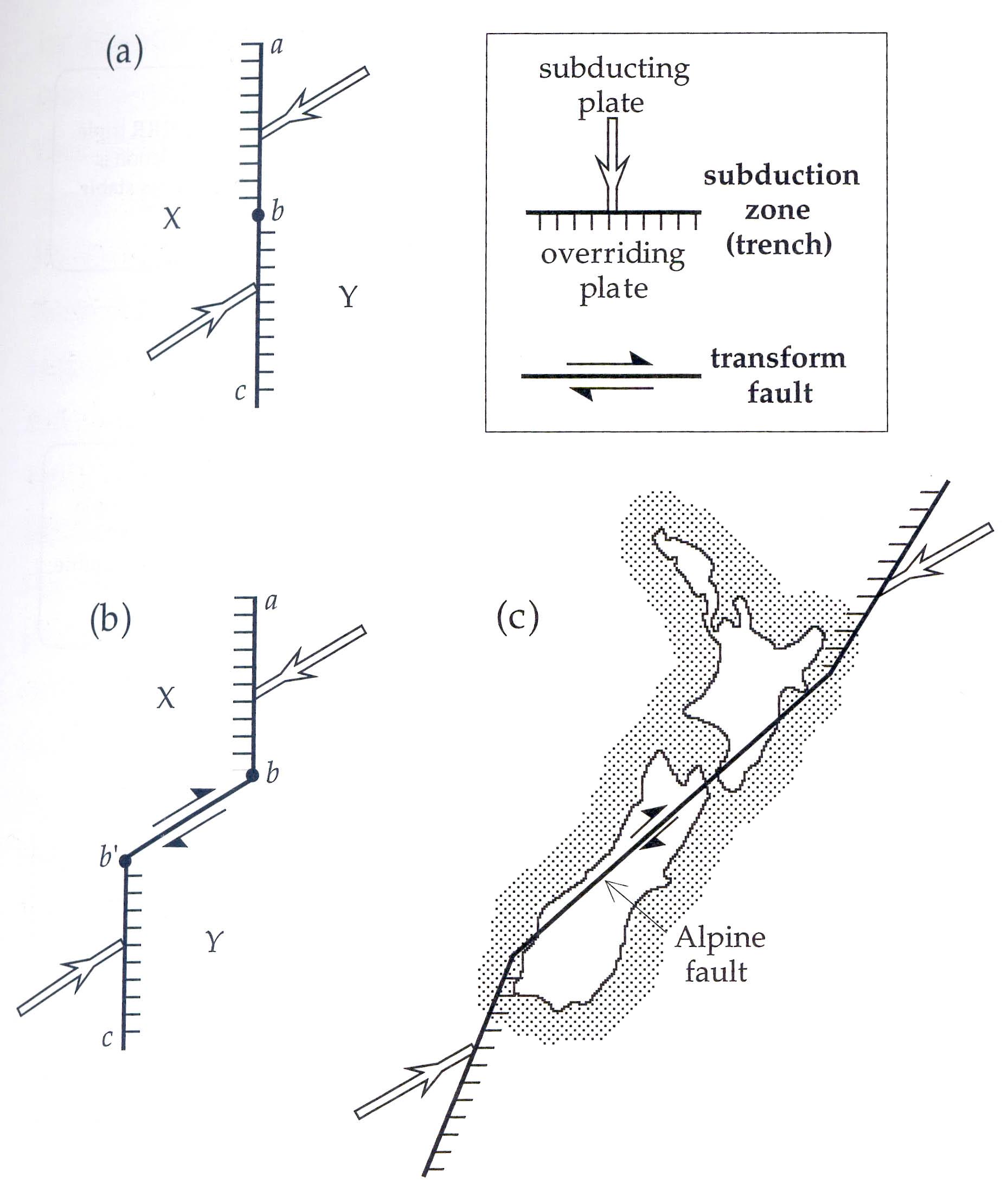
1.2.6.3 Conservative margins
Transform faults are strike-slip faults with steeply dipping fault planes. They may link segments of subduction zones, but they are mostly observed at constructive plate margins where they connect oceanic ridge segments. Transform faults are the most seismically active parts of a ridge system, because here the relative motion between neighboring plates is most pronounced. Seismic studies have confirmed that the displacements on transform faults agree with the relative motion between the adjacent plates.
The trace of a transform fault may extend away from a ridge on both sides as a fracture zone. Fracture zones are among the most dramatic features of ocean-floor topography. Although only some tens of kilometers wide, a fracture zone can be thousands of kilometers long. It traces the arc of a small circle on the surface of the globe. This important characteristic allows fracture zones to be used for the deduction of relative plate motions, which cannot be obtained from the strike of a ridge or trench segment, where oblique spreading or subduction is possible (note, for example, the direction of plate convergence relative to the strike of the Aleutian island arc in Fig. 1.11).
Any displacement on the surface of a sphere is equivalent to a small rotation about a pole. The motion of one plate relative to the other takes place as a rotation about the Eider pole of relative rotation between the plates (see Section 1.2.9). This pole can be located from the orientations of fracture zones, because the strike of a transform fault is parallel to the relative motion between two adjacent plates. Thus a great circle normal to a transform fault or fracture zone must pass through the Euler pole of relative rotation between the two plates. If several great circles are drawn at different places on the fracture zone (or normal to different transform faults offsetting a ridge axis) they intersect at the Euler pole. The current model of relative plate motions NUVEL-1 was obtained by determining the Euler poles of rotation between pairs of plates using magnetic anomalies, the directions of slip on earthquake fault planes at plate boundaries, and the topography that defines the strikes of transform faults. The rates of relative motion at different places on the plate boundaries (Fig. 1.11) were computed from the rates of rotation about the appropriate Euler poles.
There may be a large change in elevation across a fracture zone; this is related to the different thermal histories of the plates it separates. As a plate cools, it becomes more dense and less buoyant, so that it gradually sinks. Consequently, the depth to the top of the oceanic lithosphere increases with age. i.e., with distance from the spreading center. Places facing each other across a transform fault are at different distances from their respective spreading centers. They have different ages and so have subsided by different amounts relative to the ridge. This may result in a noticeable elevation difference across the fracture zone.
Ultrabasic rocks are found in fracture zones and there may be local magnetic anomalies. Otherwise, the magnetic effect of a transform fault is to interrupt the oceanic magnetic lineations parallel to a ridge axis, and to offset them in the same measure as ridge segments. This results in a very complex pattern of magnetic lineations in some ocean basins (e.g., in the northeast Pacific).
A transform fault can also connect subduction zones. Suppose a consuming plate boundary consisted originally of two opposed subduction zones (Fig. 1.19a). Plate Y is consumed below plate X along the segment ab of the boundary, whereas plate X is consumed beneath plate Y along segment be. The configuration is unstable, because a trench cannot sustain subduction in opposite directions. Consequently, a dextral transform fault develops at the point b. After some time, motion on the fault displaces the lower segment to the position b'c (Fig. 1.19b). An example of such a transform boundary is the Alpine fault in New Zealand (Fig. 1.19c). To the northeast of North Island, the Pacific plate is being subducted at the Tonga-Kermadec trench. To the southwest of South Island, the Pacific plate overrides the Tasman Sea at the anomalous Macquarie Ridge (earthquake analysis has shown that the plate margin at this ridge is compressive; the compression may be too slow to allow a trench to develop). The Alpine fault linking the two opposed subduction zones is therefore a dextral transform fault.

Fig. 1.19 (a! A consuming plate boundary consisting of two opposed subduction zones; along ab plate Y is consumed below plate X and along be plate X is consumed beneath plate Y. (b) Development of a transform fault which displaces be to the position b'c. (c) The Alpine fault in New Zealand is an example of such a transform boundary (after McKenzieand Morgan, 1969).
